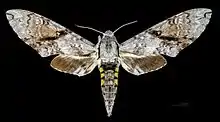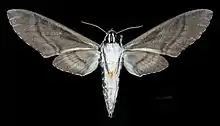Manduca andicola
Manduca andicola is a moth of the family Sphingidae first described by Walter Rothschild and Karl Jordan in 1916. It is found from Central America to Peru, Ecuador, Bolivia and Argentina.[2]
| Manduca andicola | |
|---|---|
 | |
| Dorsal view | |
 | |
| Ventral view | |
| Scientific classification | |
| Kingdom: | Animalia |
| Phylum: | Arthropoda |
| Class: | Insecta |
| Order: | Lepidoptera |
| Family: | Sphingidae |
| Genus: | Manduca |
| Species: | M. andicola |
| Binomial name | |
| Manduca andicola | |
| Synonyms | |
| |
It is similar to Manduca lefeburii, Manduca incisa and Manduca jasminearum in having a relatively uniform forewing upperside with a conspicuous, rather diffuse dark band running from about midway along the costa to the outer margin and incorporating the discal spot.
Adults fly as three generations in the subequatorial zone, with adults on wing from December to January, May to June and in October.
The larvae feed on plants in the family Annonaceae.
References
- "CATE Creating a Taxonomic eScience - Sphingidae". Cate-sphingidae.org. Archived from the original on 2012-11-14. Retrieved 2011-11-01.
- "Silkmoths". Silkmoths.bizland.com. 2010-06-15. Archived from the original on 2012-08-14. Retrieved 2011-11-01.
This article is issued from Wikipedia. The text is licensed under Creative Commons - Attribution - Sharealike. Additional terms may apply for the media files.